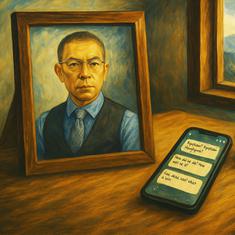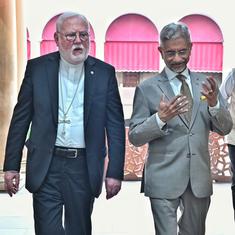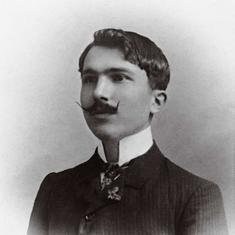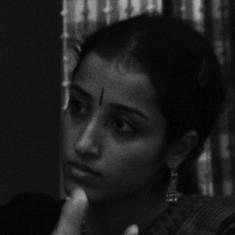Determining the “best” – or most zeitgeisty – music of 2015 seems straightforward at first. The hard numbers of sales, downloads, streams, and billboard charts seem to do all the work for us.
But do these measures tell us anything meaningful about music’s nature and value in 2015, in all its richness and diversity?
Going by Spotify’s revelation that the most-streamed song – not just of of 2015 but of all time – was Lean On, The Atlantic was able to declare the Major Lazer/DJ Snake/MØ collaboration the most 2015-iest song of the year.
Lean On is something of a catchy cultural mish-mash – a Danish singer, a French Rapper, an American/Trinidadian electronic dance music trio, and a music video shot in India.
But does being very much of its time and massively popular equate to emblematic or iconic musical status? As stand-in for the sound of a whole year?
As The Atlantic articles observes, there are vast swathes of the population who have never heard of Major Lazer. Streaming is still not the principle mode of consumption in the divergent delta system that is modern music, and success in streaming doesn’t necessarily convert into success in the broader musical world.
Lean On, on its own, is unlikely to register as a meaningful or adequate encapsulation of musical culture of 2015. Music’s complex patterns of consumption – not to mention the subjectivities and intangibilities of musical meaning itself – thwart such assessments.
Values and deep listening
When I think about what the year sounded like, I don’t hear a literal form of music so much as a relationship to music. A relationship informed by value and values, expressed in a variety of (mostly) beautiful ways.
At the cruder end of the spectrum is the economic value derived from our nostalgic attachment to music. This year, for example, Kurt Cobain’s famous MTV-Unplugged green sweater sold at auction for $137,500. John Lennon’s acoustic guitar – linked to the recording of Love Me Do – sold for more than $2.4 million.
But it’s value that can’t be expressed in dollars that really sustains us as human beings – artistic value, emotional value, the value of beauty. For example, 2015 was a year that an important 12-minute long composition by Igor Stravinsky was discovered.
Thought irretrievably lost for 100 years, the emergence of this never-before-heard music by Stravinsky is tremendously exciting.
Similarly, back in the pop world, even as streaming and the triumph of easily digested tracks over long-form listening becomes a fact of life, the emerging critical successes in 2015 are still the artistically ambitious albums, not necessarily the biggest sellers.
Kendrick Lamar’s To Pimp a Butterfly, already hailed as a masterpiece, is an awe-inspiring 80-minute musical canvas that weaves a densely rich lyrical and musical narrative. It seems to resist the “concept album” label – so utterly packed with ideas is it that the term seems reductive. Novelistic is not an inappropriate description for an album that rewards repeat listenings so richly.
Björk and Sufjan Stevens have also released albums that function as whole artistic experiences. Raw confessional journeys – the former through divorce (Vulnicura), the latter through the death of a mother (Carrie and Lowell) – these albums require and reward deep listening.
And what could be more necessary (and therefore worthy of “music of the year” acknowledgement) in 2015 than the reward of deep listening? Deep listening resists the demands of the insane pace of modern digital media, and immunises against the depressive impact of being bombarded by current affairs.
It’s comforting to think that technology has its limits, that the album persists, and that streaming hasn’t killed our appetite for sustained listening.
This the-more-things-change-the-more-they-stay-the-same dynamic was also observable in some genuine opera-based innovation in 2015. Those frequently occurring proclamations of opera’s death are greatly exaggerated, Twain-style, if East Los Angeles was anything to go by in recent months.
Possibly the most exciting, daring, and adventurous musical event of the year was courtesy of LA’s independent opera company, The Industry. Called Hopscotch, this incredible feat of distributed creativity practically re-conceived an entire art form.
You certainly had to be there to experience it though – half of the opera happened in limousines, where audience members were seated next to opera singers and musicians performing in-vehicle, ferried from location to location for interconnected scenes around the streets, parks, concrete river systems, and the tops of buildings throughout East LA.
It’s fascinating to consider that one of the most innovative and transformative musical experiences of the year came from the most “heritage” of musical art forms.
Musical values and politics
Sometimes, the sound of 2015 was obscured by the fury. Living and breathing music was hard to hear above the furious din of a mediascape hellbent on reflecting back to us the world’s apparent and ever more rapid disintegration.
In this context, choosing to listen to music instead of using free time to catch up on current events almost feels like a form of denial. A protective cocoon at best, a guiltily buried head in the sand at worst.
As a former Los Angeles commuter, the car radio station decision – news or music? – will always be a serious one for me. The dilemma felt more intense this year with the sound of gunfire never far away in the news. Perhaps the discharge of weaponry around the world was the true sound of 2015.
Yet music was to be found here too, for better or worse. There was the realisation that music is part of ISIS’s propaganda arsenal. Music-infused social media is being used, rather terrifyingly, to sneak into the minds of disaffected, and recruitable, youth in societies all around the globe – a powerful tool in its stealthy invasion of the able-bodied snatchers.
In Australia, reverberations around a contentious federal arts policy were felt across the year. To some sectors of society, it was a surprising fuss over a pitiable amount of money (compared to, say, state subsidised mining infrastructure).
But Australians generally respond when the less powerful aren’t getting a fair go. And of course it’s the most impacted small to medium arts sector where the truly innovative art and music is actually produced.
With music being a major player in that fight, it was heartening to hear the multitude of voices speaking up for the value of maintaining government investment in culture. Less heartening has been the result of all the impassioned protest.
At least the politics of gender in the symphonic world made some small progress in 2015. As usual, we saw a slightly boring plethora of male appointments to Chief Conductorships around the world this year.
In contrast, the Queensland Symphony Orchestra emerged as a leader, with its appointment of Alondra de la Parra as Music Director from 2017. She will be the first conductor in the history of Australia’s orchestral system to have that role.
Following the American usage, the title implies a more powerful role than Chief Conductor, encompassing a broader remit of responsibilities.
Similarly, while female rock is probably further advanced than classical conducting in terms of gender balance, it has been wonderful to see the rise and rise of Courtney Barnett in 2015.
Like so much popular music this year, it’s Barnett’s lyrics that are drawing the most attention attention. But the Nirvana-like physicality and energy of her act is also a compelling and refreshing presence. There’s still juice in the tank of rock, and this too provides some comfort.
Paris – Hymn to a Great City
As the world worsens, or at least seems to, the precious value of art is more keenly felt, not less. For some, the story of the pianist playing Imagine in the streets of terrorised Paris last October was a balm.
It was a chance to experience music as consolation, as solace.
Significantly, 2015 saw the celebration of Arvo Pärt's 80th birthday, the Estonian composer most famous for the beautiful Spiegel im Spiegel. Try listening all the way through to his Hymn to a Great City, and see if doesn’t also move you some distance towards hope for humanity.
In some ways, 2015’s music was like any other year’s – another noisy mass of human-generated sound across ever-expanding and evolving stylistic categories that no individual can realistically keep track of.
But hopefully this snapshot of 2015’s music shows that the beating heart of the messy soundworld is something immeasurably valuable. That is the potential for music, through so many avenues, to sustain a life worth living.
Liam Viney, Piano Performance Fellow, The University of Queensland
This article was originally published on The Conversation.










